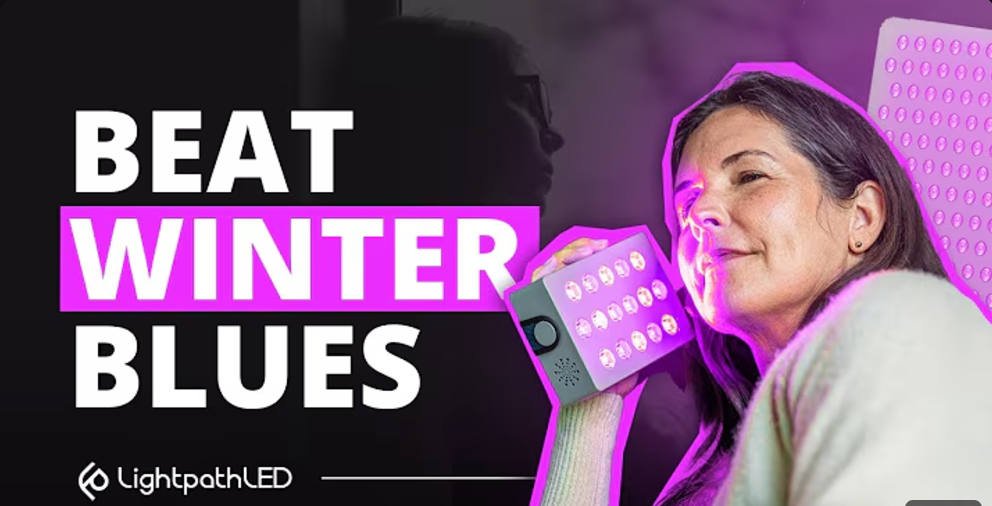As the days grow shorter and the amount of natural sunlight is reduced, many people start to experience low moods and a plunge in energy, along with disturbances in overall well-being. Commonly referred to as seasonal affective disorder, this is a form of depression associated with reduced daylight hours. Symptoms can include low energy, changes in sleep patterns, difficulty concentrating, and feelings of hopelessness. Fortunately, light therapy, especially with blue, red, and near-infrared light, has emerged as a promising way to alleviate these symptoms.
The Role of Blue Light in Combating SAD
Blue light has long been recognized for its therapeutic benefits. Here's how it helps:
- Boosts Serotonin Levels: Blue light exposure stimulates serotonin production, a neurotransmitter responsible for mood regulation. Low levels of serotonin have been closely linked to depression.
- Regulates Melatonin: During winter, the short daylight hours can overactivate melatonin, a sleep hormone. Blue light suppresses this hormone during the day, thus normalizing sleep-wake patterns.
- Aligns Circadian Rhythms: Blue light works by resetting that internal clock or circadian rhythm of the human system, which is usually misled in patients with SAD. It resets the pattern for the normalization of sleep and the stabilization of mood.
Best Practice:Blue light therapy is most effective in the morning. A session every morning of 15–30 minutes can greatly improve mood and energy levels over time.
The Benefits of Red and Near-Infrared Light
While blue light emulates natural sunlight in normalizing the human body's circadian rhythms, red and near-infrared light acts differently. It permeates deeper into tissues and increases the production of energy at the cellular level.
- Increases ATP Production: Red and near-infrared light trigger the mitochondria, the powerhouse of the cell, to produce more ATP, a form of energy currency that the cells use. As a result, this can benefit brain function, enhance mood, and reduce symptoms of depression.
- Reduces Inflammation: Long-term inflammatory processes are associated with depression and cognitive decline. Red and near-infrared light will have powerful anti-inflammatory action that contributes to brain and body health.
- Promotes Neuroprotection: Photons within these wavelengths have the effect of protecting neurons and promoting angiogenesis and synaptogenesis, or the creation of new synapses, which improves neural function.
- Improves Sleep: Red and near-infrared light does not suppress melatonin as blue light does; thus, it is suitable for evening use to help enhance sleep quality without interfering with natural sleep patterns.
The Power of Pulsing Light Therapy
Adding pulsing, or turning the light on and off at certain frequencies, can further enhance the benefits of light therapy:
- Brain Entrainment: Pulsing light at specific frequencies can promote brain states associated with alertness, focus, or relaxation. For instance:
- 40 Hz (Gamma): Best in the morning to improve focus and energy.
- 8–12 Hz (Alpha/Theta): Ideal in the evening to promote calmness and relaxation.
- Improves Cellular Response: Pulsing allows the cells to rest between light exposure and increase ATP production, reducing overstimulation.
- Synchronizes Circadian Rhythms:Pulsing emulates the natural rhythms of sunlight to help regulate sleep-wake cycles more so than continuous light.
Research on Light Therapy
Recent studies support the effectiveness of blue, red, and near-infrared light therapy. For example:
- A 2021 study reported that blue light pulsed at 40 Hz significantly enhanced memory, alertness, and brain function. It even enhanced circadian rhythm alignment, especially in the hippocampus, which is that part of the brain related to memory.
- Many studies using red and near-infrared light have demonstrated positive effects in reducing inflammation, improving cognitive function, and lowering symptoms of anxiety and depression.
Combining Blue, Red, and Near-Infrared Light Therapy
The use of all three wavelengths in conjunction with pulsing provides a comprehensive approach to combating SAD and improving overall well-being. This multi-light therapy approach:
- Boosts mood and energy.
- Improves sleep patterns.
- Reduces inflammation and supports brain health.
- Improves focus and productivity, especially for those in northern climates with limited daylight during winter.
Practical Tip: Use blue light therapy in the morning for enhanced mood and alertness; change to low-frequency red and near-infrared light in the evening for relaxation and sleep enhancement.
Final Thoughts
Light therapy is a science-backed, non-invasive intervention for effectively managing SAD and improving mental health. One can fight the winter blues by adding blue, red, and near-infrared light to their daily routine and helping the body maintain its rhythms. View our best-selling Diesel Tabletop.
Whether one is fighting gray skies or tougher struggles during the duller months of the year, light therapy is a safe and highly effective solution for improving mood, energy, and general well-being.
Take the first step into brighter days ahead, and let the sunshine in!


